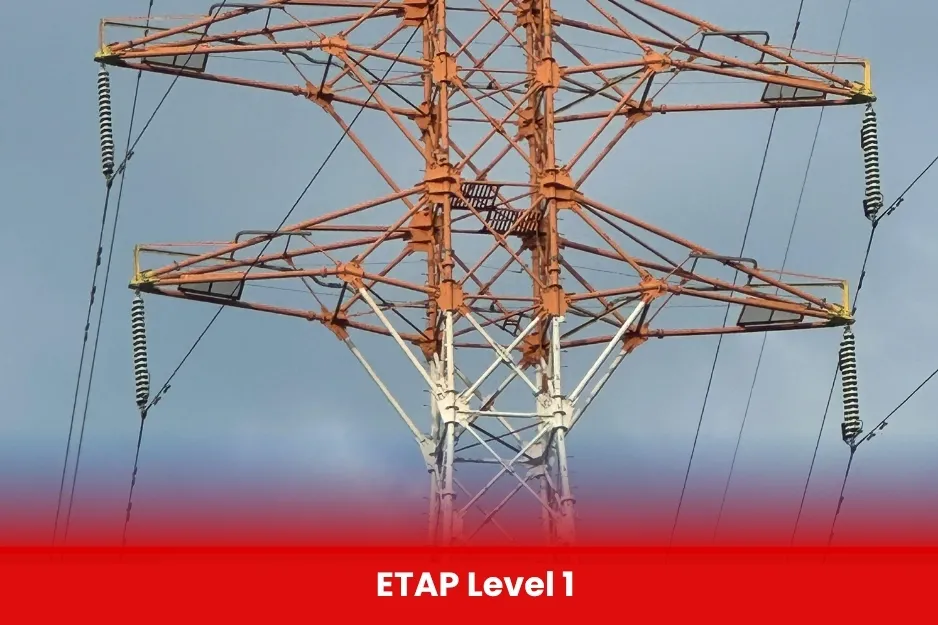ETAP Level 1
ETAP Level 1 by Burraq UK is a beginner-level training program designed to introduce participants to the fundamentals of ETAP software for power system analysis. Offered by a leading UK-based technical training provider, the course focuses on modeling, simulating, and analyzing electrical networks using ETAP. It’s ideal for engineering students, professionals, and technicians looking to build practical skills in electrical system design and analysis.

Aim of ETAP Level 1
The aim of ETAP Bootcamp Level 1 is to provide participants with a solid foundation in power system modeling and analysis using ETAP software. The course is designed to develop practical skills in creating single-line diagrams, simulating electrical systems, and performing basic load flow studies. By the end of the training, participants will be equipped to use ETAP for real-world power system applications and prepared for more advanced levels of analysis.
Course Overview
ETAP Level 1
- Educational Background:
Diploma holders, undergraduate, or graduate students in Electrical Engineering, Power Engineering, or related technical fields. - Basic Knowledge:
Familiarity with electrical circuit concepts, power systems, and single-line diagrams is recommended. - Professionals:
- Engineers, technicians, or working professionals in the power, energy, or industrial automation sectors looking to enhance their ETAP skills.
| Course Code | Curriculum Title | Credit | DLH |
|---|---|---|---|
| BUK1130-1 | Introduction & Setup | 2 | 20 |
| BUK1130-2 | Single-Line Diagram (SLD) Development | 2 | 20 |
| BUK1130-3 | Load Flow and Voltage Analysis | 2 | 20 |
| BUK1130-4 | Equipment Evaluation & Transformer Studies | 2 | 20 |
| BUK1130-5 | Alerts, Critical Conditions, and Protection | 2 | 20 |
| BUK1130-6 | Motor Starting Studies | 2 | 20 |
| BUK1130-7 | Reporting & Next Steps | 2 | 20 |
| BUK1130-8 | Reporting & Continuation | 2 | 20 |
Module : 1 Introduction & Setup
- ETAP software installation
- Understanding the user interface & toolbar
- Creating a new project or loading an existing one
- Project database navigation and setup
Module 2. Single-Line Diagram (SLD) Development
- Drawing and editing a one-line diagram
- Adding electrical components (buses, breakers, transformers, cables, loads, etc.)
- Creating composite networks
- Using templates and customizing libraries (relays, breakers, fuses)
Module 3.Load Flow Analysis
- Performing load flow (power flow) studies
- Bus voltage profiles
- Cable voltage drop & overload analysis
- Identifying under-voltage and overloaded equipment
- Cable sizing based on load & voltage criteria
Module 4. Equipment Evaluation & Transformer Analysis
- Evaluating performance of transformers, motors, cables, and breakers
- Transformer overload detection
- Transformer sizing based on system demands
Module 5. Short Circuit & Arc-Flash Analysis
- Modeling and simulating fault scenarios
- Three-phase, single-line-to-ground, double-line faults
- Arc-flash boundary and PPE calculation
- Breaker and CT settings
- Fault current evaluation
- Protection coordination basics
Module 6. Motor Starting Analysis
- Static and dynamic motor start simulations
- Input of motor data (starting current, inertia, load torque)
- Voltage dip and starting time calculation
- Use of soft starters and VFDs
- Plotting motor acceleration curves
Module 7. Alert View & Critical Conditions
- Identifying and resolving critical/marginal conditions in the system
- Alerts for under-voltage, overload, or over-current issues
- Using Alert View for visual diagnostic
Module 8. Report Generation
- Generating standard reports (load flow, short circuit, motor start, arc-flash)
- Exporting reports to Excel or PDF
- Customizing report layout and filters
- Undergraduate or graduate students studying electrical engineering or related fields
- Those who want practical, hands-on experience with power system modeling software.
- Professionals working in power generation, transmission, distribution, or industrial electrical systems.
- Recent graduates wanting to improve employability by adding ETAP software skills to their resume.
All Modules within this qualification are assessed internally by the approved training Centre and externally verified by BURRAQ UK. The program uses a criterion-referenced assessment approach to ensure that learners successfully meet all required learning outcomes.
A Pass in any unit is granted only when the learner submits valid, reliable, and authentic evidence that demonstrates achievement of the assessment criteria. The Assessor is responsible for reviewing this evidence and confirming that the learner has attained the expected standard.
To guarantee fairness, transparency, and consistency, assessors are required to maintain a detailed audit record, clearly documenting the basis of their assessment decisions in line with quality assurance requirements.
